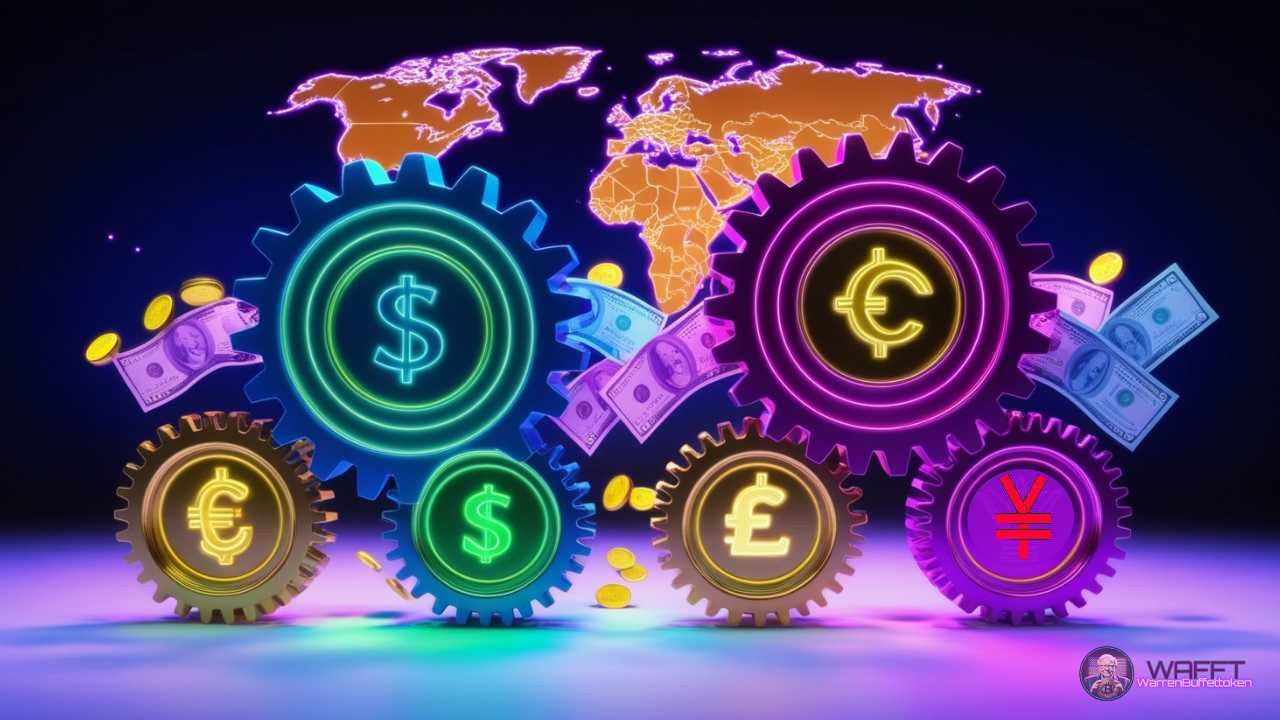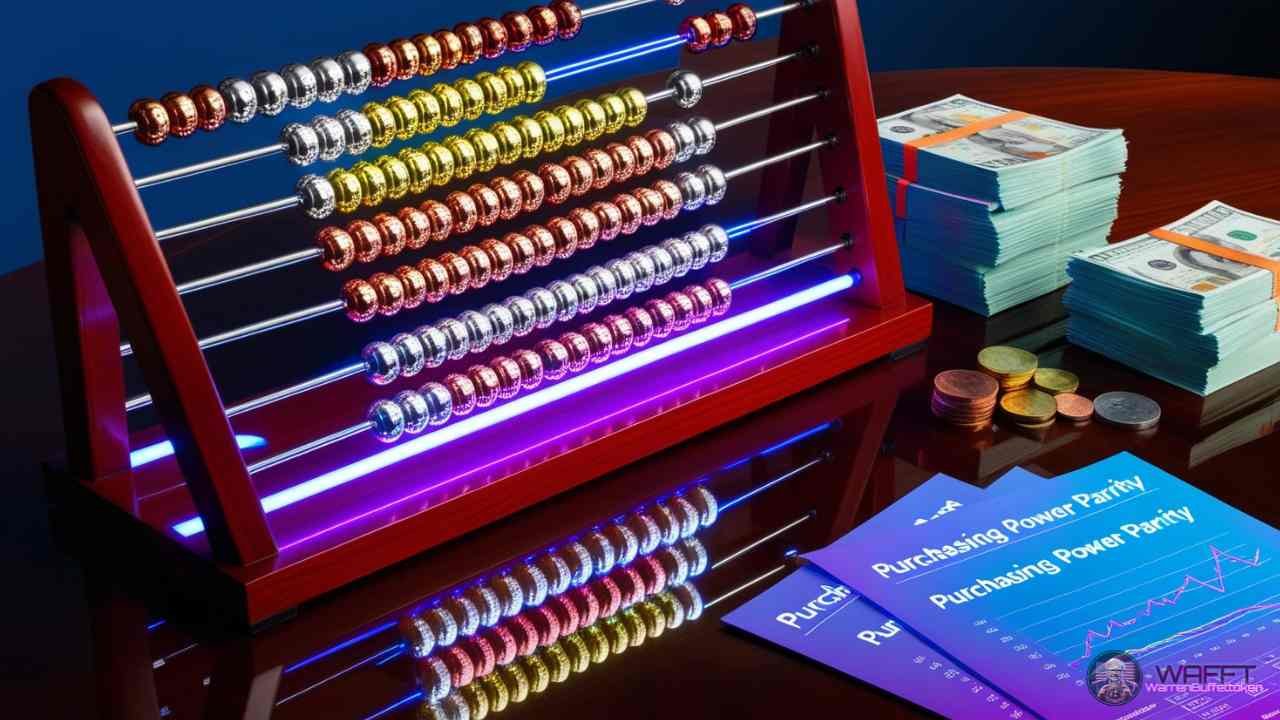Purchasing Power Parity (PPP):
Cracking the Enigma of the Value of Money 💰🌍
Have you ever wondered why a cup of coffee costs $2 in one city and $5 in another, even though both use the same currency? 🤔 Or maybe you’re surprised by how living in one city can be so expensive compared to another, even though salaries are similar. Purchasing Power Parity (PPP) is an economic concept that helps us understand why this happens and how we can compare the value of money in different countries and regions. 🌍💸
In this article, we break down what PPP is, how it works, its importance, its limitations, and its role in the global economy. So get ready, because we’re going to take you on a journey through the interesting world of PPP. 🚀

What is Purchasing Power Parity (PPP)? 🤔
Purchasing Power Parity (PPP) is an economic theory that holds that over the long run, the exchange rate between two currencies should adjust so that the same good or service has the same price in two different countries when converted to the same currency. 🌍💱
That is, according to PPP, $1 in the US should buy the same thing as the equivalent of $1 in Mexico, Japan, or any other country, if the prices of goods and services were completely balanced. 🏷️
Basic example:
- In New York, a hamburger costs $5.
- In Mexico City, a hamburger costs 100 Mexican pesos.
If PPP theory holds, then the exchange rate between the dollar and the peso should be 20 pesos per dollar (100 pesos / 5 dollars), since 20 Mexican pesos should buy the same thing as 1 US dollar.
The idea behind PPP is that over time, price differences between countries should disappear due to the law of one price. In an ideal world, goods and services would cost the same everywhere if we convert them to the same currency, eliminating any arbitrary gains from exchange rates. 🌐💱 (The idea🤔)
and now the definitive example🤯🫂:
Let’s remember that according to PPP (Purchasing Power Parity), if a burger 🍔 costs 5 dollars in New York and 100 Mexican pesos in Mexico City, the implied exchange rate should be 20 pesos per dollar. This means that, in theory, with 100 Mexican pesos, you could buy something equivalent to what can be bought with 5 dollars in the U.S. 💵🇲🇽
What happens in reality? 🤔
To understand how this works in practice, we need to see what the current nominal exchange rate is and compare prices. 💱📊
Nominal exchange rate (as of October 2024): approximately 18 Mexican pesos per dollar.
Using the nominal exchange rate, 100 Mexican pesos are converted into approximately 5.56 dollars 💵
Purchasing power in Mexico vs. the U.S. 🇲🇽🇺🇸
Although the nominal exchange rate converts 100 pesos into 5.56 dollars, what matters is what can be bought with those 100 pesos in Mexico compared to what can be bought with 5.56 dollars in the U.S. This is where real purchasing power comes into play, taking into account differences in cost of living and local prices. 💸🏡
- In Mexico: With 100 pesos, you could buy a burger 🍔 from a fast food chain and still have some left for a small drink or side in some cases. 🥤🍟 Generally, the cost of living in Mexico is lower, and the prices of many everyday goods and services (like food, transportation, or housing) are more affordable compared to the U.S. 🇲🇽
- In the U.S.: With 5.56 dollars, the margin is much tighter. In expensive cities like New York 🏙️, 5 dollars would probably not be enough for a standard fast food burger (like at McDonald’s 🍔), as they typically cost between 6 and 8 dollars or more, depending on the location. This reflects the higher cost of living in the U.S. 🌆💸
At first glance, this seems roughly similar to the PPP-estimated value (20 pesos per dollar), suggesting that the burger costs the same in both countries. However, there are key differences that affect real purchasing power. ⚖️💡
Difference in real purchasing power🌎🔗
In terms of purchasing power, an American needs to spend more money to buy the same hamburger because of the higher cost of living. For example, in a city like New York, the average salary is higher, but so are the prices of goods and services. Meanwhile, in Mexico, although salaries are lower, so are the prices of many basic products.
- Average salary in the U.S.: About $4,000 to $5,000 per month, depending on the state.
- Average salary in Mexico: About 15,000 to 20,000 pesos per month (which is about $800 to $1,100 per month).
Although salaries in the U.S. are significantly higher in nominal terms, a larger portion of that income goes toward covering higher expenses, such as rent, food, and health care.
Let’s dig even deeper:🕵️Average salary in the US vs. Mexico 🇺🇸🇲🇽
The average salary is a key indicator to understand the purchasing power and standard of living in a country. Let’s compare the income of an average American to that of an average Mexican, taking into account the differences in the cost of living. 🏡💰
🇺🇸 Average salary in the US
In the United States, salaries vary widely by state, industry, and occupation.
Here are some average data:
- Average annual salary in the US in 2024: Approximately $60,000 to $70,000 per year. 💵
- Average monthly salary: This equates to about $5,000 to $5,800 per month before taxes. 🧾
Salaries in the US are significantly higher than in many other countries, but so is the cost of living. 🏙️ In large cities like New York or San Francisco, salaries tend to be higher 💼, but housing, food, transportation, and healthcare costs are also considerably high. 🏠🍔🚗🩺
🇲🇽 Average salary in Mexico
In Mexico, salaries are lower in absolute terms, but the cost of living is also lower, meaning the amount of goods and services that can be purchased with the salary is different. 🛒
Here is the most recent data:
- Average annual salary in Mexico: Approximately 180,000 to 240,000 pesos per year. 💵
- Average monthly salary: This is equivalent to between 15,000 to 20,000 pesos per month, which is approximately $800 to $1,100 dollars per month, depending on the exchange rate. 💸💱
This type of comparison helps to understand how the standard of living varies between countries and how important it is to take into account both salary and cost of living. 🌎👨👩👧👦

⚖️ Purchasing power comparison 🏙️💰
Although the average salary in the US is considerably higher 💵, purchasing power does not only depend on nominal income, but also on local prices 🏠🛍️.
In terms of PPP (Purchasing Power Parity), many everyday products and services are cheaper in Mexico, allowing people with a relatively low income to cover their basic needs more affordably. 🍽️💡
🏠 Example of common expenses 🛒💸
Rent 🛏️:
- In the US, the average rent for a one-bedroom apartment in a major city like New York is around $2,500 to $3,500 per month. 🏢💸
- In Mexico, the average rent for a similar apartment in a city like Mexico City is 10,000 to 20,000 pesos per month, which is about $550 to $1,100 USD. 🏙️💵
🚇 Transportation 🚍:
- In the US, a monthly public transportation pass in cities like New York costs around $127 USD.🚇💰
- In Mexico, a monthly public transportation pass in Mexico City costs around 400 pesos, which is about $22 USD. 🚋💳
🍔 Food 🌮:
- In the US, an average fast food meal can cost between $8 to $12 USD. 🍕🍟
- In Mexico, a similar fast food meal can cost between 80 to 150 pesos (about $4 to ). 🌮🍔
📊 Conclusion 🧮:
- Average salary in the US: $5,000 to $5,800 dollars per month before taxes. 💵
- Average salary in Mexico: 15,000 to 20,000 pesos per month, which is equivalent to $800 to $1,100 dollars. 💵🇲🇽
Although the salary in the US is higher, the cost of living is also much higher, which reduces the purchasing power of citizens compared to Mexico. In Mexico, incomes are lower, but many goods and services are more affordable 💸🛍️.
Therefore, PPP plays an important role in adjusting these differences and showing the real purchasing power in each country. 🌍📉

How does PPP work? ⚙️
Purchasing Power Parity is based on the premise that prices of goods and services tend to equalize across countries due to supply and demand.
This happens because tradable goods (products such as clothing, food, and cars) can be imported and exported. If a good is cheaper in one country than another, businesses and consumers will seek to take advantage of the difference, leading to an adjustment in prices and exchange rates.
What does this mean for currencies? 💱
If goods are cheaper in one country than another, that country’s currency should appreciate (increase in value) to balance the price. Conversely, if goods are more expensive, the currency should depreciate (lose value). This adjustment in exchange rates is what is known as a PPP adjustment.
For example, if prices in a country rise rapidly due to inflation, PPP suggests that the country’s currency should depreciate against other currencies to restore equilibrium in purchasing power.
History of PPP 📜
⚖️ Purchasing power comparison 🏙️💰
Although the average salary in the US is considerably higher 💵, purchasing power does not only depend on nominal income, but also on local prices 🏠🛍️.
In terms of PPP (Purchasing Power Parity), many everyday products and services are cheaper in Mexico, allowing people with a relatively low income to cover their basic needs more affordably. 🍽️💡
🏠 Example of common expenses 🛒💸
Rent 🛏️:
- In the US, the average rent for a one-bedroom apartment in a major city like New York is around $2,500 to $3,500 per month. 🏢💸
- In Mexico, the average rent for a similar apartment in a city like Mexico City is 10,000 to 20,000 pesos per month, which is about $550 to $1,100 USD. 🏙️💵
🚇 Transportation 🚍:
- In the US, a monthly public transportation pass in cities like New York costs around $127 USD.🚇💰
- In Mexico, a monthly public transportation pass in Mexico City costs around 400 pesos, which is about $22 USD. 🚋💳
🍔 Food 🌮:
- In the US, an average fast food meal can cost between $8 to $12 USD. 🍕🍟
- In Mexico, a similar fast food meal can cost between 80 to 150 pesos (about $4 to ). 🌮🍔
📊 Conclusion 🧮:
- Average salary in the US: $5,000 to $5,800 dollars per month before taxes. 💵
- Average salary in Mexico: 15,000 to 20,000 pesos per month, which is equivalent to $800 to $1,100 dollars. 💵🇲🇽
Although the salary in the US is higher, the cost of living is also much higher, which reduces the purchasing power of citizens compared to Mexico. In Mexico, incomes are lower, but many goods and services are more affordable 💸🛍️.
Therefore, PPP plays an important role in adjusting these differences and showing the real purchasing power in each country. 🌍📉
Did you know?
Purchasing Power Parity is not a new idea. In fact, it was introduced by Swedish economist Gustav Cassel in 1918 to try to explain the imbalances in exchange rates following World War I.
Prior to this, many countries used the gold standard, which kept exchange rates relatively stable. However, after the war, the world abandoned this system, and exchange rates fluctuated more freely. This is when the need arose for a theory that explained how exchange rates should behave based on relative prices in different countries. 🌍💡
Although PPP was popularized after World War I, the underlying idea that prices should be equalized across countries has been present in economic theory for a long time.
Types of PPP: Relative and Absolute ⚖️
There are two main versions of PPP: absolute and relative.
1. Absolute PPP 📊
Absolute PPP holds that prices of goods and services should be the same between two countries when converted to a common currency. This is the simplest and most straightforward type of PPP.
For example, if a pair of shoes costs $50 in the US and the euro equivalent is €40, then according to absolute PPP the exchange rate should be $1.25 per euro ($50/€40 = 1.25).
2. Relative PPP 📈
Relative PPP is a more practical version of the theory. It holds that exchange rates do not perfectly reflect absolute prices, but adjust over time according to inflation rates in each country.
For example, if the inflation rate is 5% in the US and 2% in the Eurozone, relative PPP suggests that the dollar should depreciate against the euro at a rate equal to the difference in inflation (in this case, 3%).
This approach is more realistic, as it recognizes that prices do not adjust instantly or perfectly, but over the long run, exchange rates will adjust according to the difference in inflation.
How is PPP measured? 🧮
To measure PPP between two countries, economists typically compare the price of a basket of goods and services that is representative of everyday life in both countries.
One of the best-known examples to illustrate PPP is the Big Mac Index, published by The Economist magazine. This index compares the price of a Big Mac burger in different countries to see if the currencies are undervalued or overvalued compared to the US dollar. 🍔💱
If, for example, a Big Mac costs $5 in the US but only €3 in Europe, the Big Mac Index suggests that the euro is undervalued against the dollar, as the price should be closer to that of the Big Mac in the US.
While the Big Mac Index is a fun and informal tool, economists often use more complex indicators, such as the consumer price index (CPI) and other inflation adjustments, to calculate PPP more accurately.

Importance of PPP in the Global Economy 🌎💹
PPP is crucial in the global economy for several reasons:
1. More accurate economic comparisons 📊
PPP allows us to make more realistic comparisons of purchasing power across countries. Exchange rates can distort the comparison of the size of economies, but PPP adjusts for those differences and provides a clearer view of a country’s true wealth.
For example, PPP-adjusted GDP per capita is a more accurate measure of living standards than nominal GDP per capita.
2. Predicting long-term exchange rates 💱
PPP is also useful for predicting long-term movements in exchange rates. If a country’s exchange rate differs significantly from what PPP suggests, the currency is likely to adjust in the future.
3. Measuring social welfare 🏡
The concept of PPP is used to measure the standard of living in different countries. By adjusting for cost of living and inflation, you can get a clearer picture of how well or poorly people are living in different regions of the world.
Limitations of PPP ⚠️
Although PPP is a useful theory, it has several limitations:
1. Transportation costs and trade barriers 🚢
The prices of goods cannot always be fully adjusted due to transportation costs or trade barriers. This means that some products may be more expensive in certain countries simply because it costs more to ship them there.
2. Differences in goods and services 🛍️
PPP assumes that goods and services in different countries are identical, but in reality, quality and preferences can vary widely. This makes accurate price comparisons difficult.
3. Non-tradable goods 🏠
PPP is most accurate for tradable goods (such as clothing or food), but less effective for non-tradable goods such as housing, education, or health services, whose prices can vary widely between countries without the possibility of adjusting for international trade.

Conclusion 📜
Purchasing Power Parity is a fundamental tool for comparing economies and understanding differences in the value of money across countries. Although it has limitations, it remains a crucial theory for understanding the dynamics of exchange rates and inflation.
In a world where the value of currencies fluctuates and economies are globalized, PPP helps us understand how prices and exchange rates are related, and how these affect our daily lives, whether when purchasing goods or traveling abroad. 🌍💸


